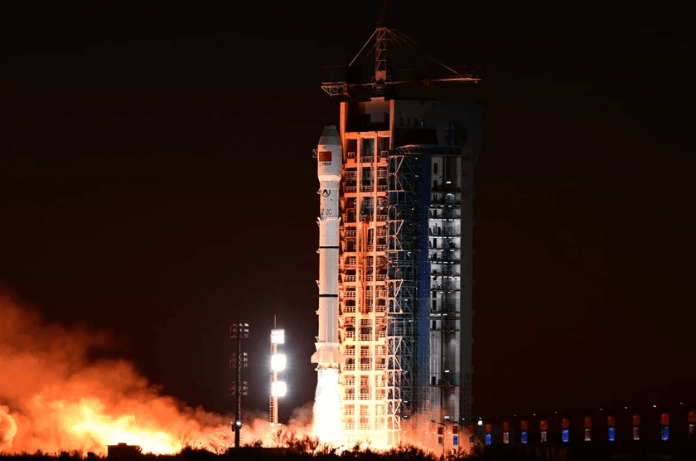China has reached a major milestone in its commercial space program by launching the world’s first autonomous or “self-driving” satellites. These satellites, designed to navigate and adjust their orbits independently, mark a new era in space exploration. According to a report, the two 4D high-resolution satellites Siwei Gaojing-2 03 and Gaojing-2 04 were launched aboard a Long March-2C carrier rocket from the Jiuquan Satellite Launch Centre on November 25.
Developed by the Shanghai Academy of Spaceflight Technology (SAST), a subsidiary of the China Aerospace Science and Technology Corporation (CASC), these satellites bring unprecedented capabilities. They promise to transform space-based surveying and mapping by reducing dependency on ground control, enabling more efficient and precise operations.
Equipped with advanced synthetic aperture radar (SAR) technology, these satellites can capture high-resolution images regardless of weather or lighting conditions. From disaster monitoring to natural resource management, their applications are vast and impactful.
China’s rapid advancements in space technology, including plans for a satellite with a humanoid robot by 2028, underscore the nation’s ambitions to lead in the space sector. Let’s explore how these groundbreaking satellites work, their unique features, and the transformative potential they hold for industries worldwide.
Autonomous Satellites: A Game-Changer in Space Exploration
The Siwei Gaojing-2 03 and Gaojing-2 04 satellites represent a leap forward in satellite technology. Unlike traditional satellites, which rely heavily on ground-based instructions, these self-driving satellites autonomously maintain and adjust their flight paths with precision.
Key features include:
- Automatic Orbit Adjustment: They can return to their designated orbits with accuracy up to 100 meters, a feat unmatched by traditional satellites.
- Formation-Coordinated Fly-Arounds: With sub-meter precision, these satellites can coordinate movements, enabling tasks like synchronized imaging and complex data collection.
These capabilities simplify satellite management, reduce operational costs, and enhance safety by minimizing human intervention.
How SAR Technology Powers Autonomous Satellites
Synthetic aperture radar (SAR) technology sets these satellites apart. Unlike traditional optical systems that depend on visible light, SAR uses microwave signals to penetrate clouds, fog, and darkness. This ensures uninterrupted data collection, regardless of weather or time.
Applications of SAR Technology
- Disaster Monitoring: SAR enables rapid assessment of areas affected by natural disasters like earthquakes and floods.
- Deforestation Tracking: High-resolution imagery aids in monitoring forest cover and illegal logging activities.
- Military Surveillance: SAR’s ability to operate in all weather conditions provides critical data for defense operations.
These features make SAR-equipped satellites indispensable for governments, industries, and scientific research.
Transformative Applications Across Industries
The Siwei satellites’ high-resolution radar imagery has far-reaching implications for numerous sectors:
- Natural Resource Management: The satellites monitor forests, water resources, and mineral deposits, providing data for sustainable development.
- Urban Safety and Infrastructure: Continuous imaging ensures timely detection of potential risks to infrastructure, enhancing public safety.
- Disaster Response: Quick access to affected areas’ imagery enables efficient coordination of relief efforts, making them a vital tool in disaster management.
- Agriculture: From estimating crop yields to monitoring land use, these satellites contribute to efficient agricultural planning.
Their ability to operate autonomously and provide real-time data strengthens their role as critical assets for modern industries.
Part of China’s Siwei Remote Sensing Constellation
The Siwei Gaojing-2 03 and 04 satellites are part of a broader initiative the Siwei commercial remote sensing constellation project. Approved by CASC in 2022, this network aims to deploy at least 28 satellites, providing comprehensive Earth observation data.
Once fully operational, this constellation will support various industries, including:
- Land management
- Marine surveillance
- Urban planning
The project highlights China’s ambition to lead in commercial space technologies and Earth observation capabilities.
Setting the Stage for Future Space Innovations
China’s recent advancements in space technology reflect its broader aspirations. The launch of autonomous satellites follows other milestones, including:
- The Ludi Tance 4-01 in August 2023, the world’s first geosynchronous orbit SAR satellite.
- The Shijian-19, a reusable and returnable satellite launched earlier this month.
Looking ahead, China plans to launch a satellite with a humanoid robot to the moon in 2028, signaling its commitment to pushing the boundaries of space exploration.
Private companies are also contributing to this momentum. For instance, Deep Blue Aerospace recently announced a space tourism program with tickets priced at $210,000 each.
Implications for the Global Space Race
China’s strides in autonomous satellite technology challenge the traditional dominance of Western space agencies. By reducing reliance on ground-based operations and offering cost-efficient solutions, these advancements position China as a leader in the growing commercial space sector.
These developments also open opportunities for international collaboration. High-resolution, all-weather imagery can support global efforts in climate change mitigation, disaster management, and sustainable development.
Pioneering the Future of Space
The successful launch of the world’s first self-driving satellites marks a pivotal moment in space technology. The Siwei Gaojing-2 03 and 04 satellites not only enhance operational efficiency but also expand the scope of satellite applications across industries.
With China leading the charge in autonomous satellite innovation, the future of space exploration looks brighter than ever. As the Siwei constellation nears completion, its data will empower industries worldwide, setting new benchmarks for Earth observation.

